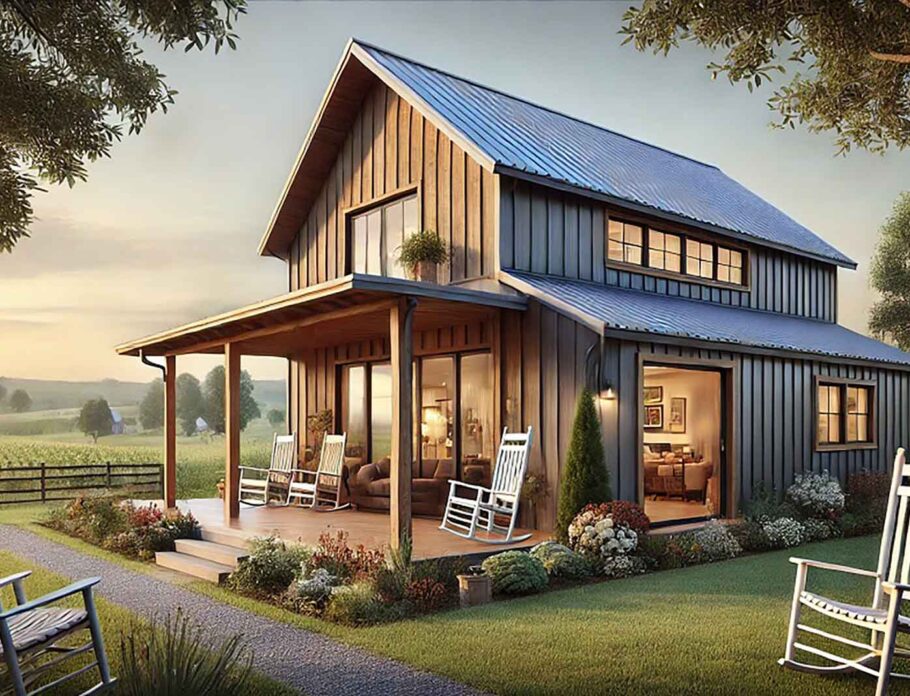Open-concept barndominiums are beautiful: huge clear spans, exposed structure, cathedral ceilings, and uninterrupted sightlines. They’re also challenging from an HVAC perspective. The very qualities that make them attractive — openness, tall volumes, lots of metal — work against traditional heating and cooling approaches. This post walks through the best HVAC strategies and system types for open-concept barndominiums, why they work, how to size and zone them, and what to watch out for during design and installation.
Why open plans and barndominiums are HVAC problem children
Before recommending systems, it helps to understand the challenges:
- Large volumes and high ceilings. Heat rises; you can end up heating the roof space rather than the living area. Cooling a tall open volume is inefficient if you use only a few ceiling outlets.
- Long sightlines, few interior walls. Zoning by rooms is harder — you’ll often need temperature control that accounts for separate activity areas rather than individual rooms.
- Metal shell issues. Metal roof and walls transfer heat quickly. In summer the shell receives and conducts solar heat; in winter it loses heat fast unless thoroughly insulated and thermally broken.
- Infiltration and thermal bridging. Poor air sealing and thermal bridges (metal framing) increase loads and undermine system performance.
- Acoustics and occupant comfort. Wide open spaces need systems that don’t blast air in ways that create drafts or excessive noise.
Understanding those issues points directly to system choices that prioritize distributed comfort, good ventilation, humidity control, and smart controls.
Top HVAC system choices (and when to use them)
- Multi-zone ducted heat pump (air-source) with variable-speed blower — best all-rounder
Why it fits: Modern air-source heat pumps (ASHP) with variable-speed compressors and ECM blowers can operate efficiently across a wide range of loads. Ducted systems can deliver conditioned air to multiple perimeter and overhead diffusers so you get even distribution in open volumes. Multi-stage compressors + variable airflow reduce drafts and short cycling.
Good for: Moderate climates, owners who want central distribution, or projects where concealed ductwork in a soffit, attic, or chase is feasible.
Pros: Efficient, reversible heating/cooling, well understood, easy to service, compatible with ERV/HRV and smart controls.
Cons: Duct design must be excellent (long runs, high leakage kill efficiency); rooftop or outdoor ASHP units require space and noise consideration.
- Ductless mini-splits (multi-head) — flexible, efficient, low-invasion retrofit option
Why it fits: Mini-splits mount heads on walls or ceilings and allow zoning without ductwork. You can place heads strategically near living, dining, and bedroom areas to account for activity and sun exposure.
Good for: Retrofits, projects with limited space for ducts, or owners wanting high efficiency and individual zone control.
Pros: High efficiency, easy to install, minimal invasive work, excellent part-load performance, independent zone control.
Cons: Visual impact (heads are visible), multiple outdoor units or larger multi-port outdoor units may be needed for large homes, cost scales up with many zones, less effective at handling ventilation and humidity without add-ons.
- VRF/VRV systems — premium option for large, complex open plans
Why it fits: Variable Refrigerant Flow (VRF/VRV) systems allow many indoor units of different types and capacities to run from a single outdoor condensing system. They provide sophisticated zoning, heat recovery between zones, and excellent part-load efficiency.
Good for: Large barndominiums with many distinct activity areas, clients wanting top performance and comfort control, and projects wanting hidden ducted or cassette heads.
Pros: Precise temperature control, quiet operation, heat recovery, flexible indoor unit choices.
Cons: Higher upfront cost, specialized contractors required for design and servicing, refrigerant charge complexity.
- Ground-source (geothermal) heat pumps — highest efficiency for long-term savings
Why it fits: Geothermal heat pumps use the stable ground temperature for heating and cooling, delivering excellent efficiency year-round. They’re particularly attractive where energy costs are high and the property has room for ground loops.
Good for: Owners planning to stay long term, properties with space for loop fields, climates with both hot summers and cold winters.
Pros: Very efficient, long equipment life, stable performance, decouples from outdoor temperature swings.
Cons: High installation cost, groundworks required, longer payback horizon.
- Hybrid approach: radiant floor heating + dedicated dehumidification + spot cooling
Why it fits: Radiant heat is ideal in tall open spaces because it delivers heat at the occupants’ level rather than heating the entire volume. Pair radiant heating (hydronic) with an air-source heat pump for cooling and a dedicated ventilation/ERV + dehumidifier for fresh air and moisture control.
Good for: Cold climates, tall volumes, those who want quiet, draft-free heating.
Pros: Comfortable, no duct losses, good for high ceilings, energy efficient if paired with efficient boiler/heat pump.
Cons: Higher up-front cost for hydronic, less flexible for rapid cooling unless combined with forced air or mini-splits.
Ventilation, humidity control, and IAQ — must-haves for barndominiums
Whatever primary system you pick, ventilation and moisture control are essential:
- ERV or HRV (energy/heat recovery ventilator): Keeps fresh air without losing conditioned energy. ERVs are preferable in humid climates because they transfer moisture as well as heat.
- Whole-house dehumidifier: Metal buildings often trap condensation; controlling humidity prevents mold, corrosion, and discomfort. In hot humid climates, a dehumidifier reduces cooling loads by allowing higher thermostat setpoints.
- Filtration and MERV rating: Use at least MERV 8–11 for typical needs; higher filtration may require larger blower capacity. Consider improving indoor air quality with activated carbon or UV for specific concerns.
- Smart ventilation control: Tie ventilation to occupancy, CO₂ sensors, and humidity sensors so you’re ventilating when you need to, not continuously wasting energy.
Distribution strategies that actually work in open spaces
- Low-induction diffusers & linear slot diffusers: These distribute air more gently across large areas and reduce drafts. Slot diffusers along beams or perimeter walls can create an even throw.
- Perimeter & high-wall placement: Avoid dumping conditioned air directly into the center of a tall room. Place supply registers at sitting/standing level around the perimeter, or use high-placement with proper throw calculations.
- Ceiling fans & destratification fans: Use reversible high-efficiency ceiling fans or destratification fans to move warm air down from the rafters in winter. This reduces heating energy for tall spaces.
- Multiple smaller outlets vs. one big register: Multiple outlets with controlled dampers produce better comfort and reduce noise and short-circuiting of conditioned air.
Zoning strategies for open plans
Instead of room-based zoning, think in activity and exposure zones:
- Sun/heat gain zones: South or west walls get more solar heat. Zone these separately.
- Activity zones: Kitchen, great room, and workspaces have different loads and schedules — treat them as separate zones.
- Sleeping zones: Bedrooms should be separately controllable for night setback.
- Occupancy sensors & smart thermostats: Use sensors to adapt to actual use patterns rather than static schedules.
Dampers and a good control strategy are critical. Variable-air systems and multi-head mini-split or VRF systems make zoning straightforward.
Sizing and design tips — do the math right
- Perform a full Manual J load calculation. Don’t “rule of thumb” the size. Open volumes, metal shells, roof overhangs, insulation levels, and infiltration all affect the load.
- Address envelope first. Better insulation, continuous air barrier, insulated sheathing, thermal breaks at metal framing, and proper roof vents or radiant barrier will shrink loads and let you buy smaller equipment.
- Design the ductwork or layout for real flows. For ducts: minimize length, maximize diameter to reduce static pressure, specify low leakage ducts, and include balancing dampers and proper diffusers.
- Plan for dehumidification and ventilation loads separately — they often drive cooling requirements in humid climates.
Cost considerations and lifecycle thinking
- Upfront vs operating cost: VRF and geothermal cost more initially but can save energy and maintenance long-term. Mini-splits are midrange upfront with low operating costs in many climates.
- Maintenance: Ducted systems need duct cleaning and filter changes; mini-splits need periodic coil cleaning and line set checks; geothermal requires loop field monitoring.
- Serviceability: Prefer systems that local HVAC contractors are experienced with. Exotic systems may cause long service intervals or expensive repairs if local techs are unfamiliar.
Practical recommendations by owner priority
- If you want the simplest, lowest-invasion installation (retrofit): Multi-head ductless mini-splits + ERV/HRV + ceiling fans.
- If you want the best comfort and hidden aesthetics: Ducted variable-speed air-source heat pump with linear diffusers and zoned dampers; add an ERV and radiant floor in bathrooms/bedrooms if desired.
- If you want top efficiency and precise zoning for a large new build: VRF/VRV with mixed indoor unit types (cassettes, ducted, wall) + ERV/HRV and integrated controls.
- If you’re building for long-term energy savings and have land: Consider geothermal heat pump + hydronic radiant floor heating + dedicated cooling zones.
Commissioning checklist — don’t skip this
- Verify Manual J and duct sizing match installed equipment.
- Perform duct leakage test and correct leaks.
- Balance airflows at diffusers and set zoning dampers.
- Commission controls and thermostats; ensure schedules and sensors are working.
- Test ERV/HRV and verify fresh air rates.
- Train the owner on setpoints, fans, and maintenance schedule.
Final thoughts
Open-concept barndominiums reward thoughtful HVAC design. The best solutions are ones that match the building’s envelope, the owner’s lifestyle, and the local climate — not the cheapest or the most conventional. Invest in a strong envelope and airtightness, pick a system that supports sensible zoning and ventilation, and prioritize humidity control. With careful planning you’ll get energy-efficient, quiet, draft-free comfort that complements the dramatic openness of your barndominium.

